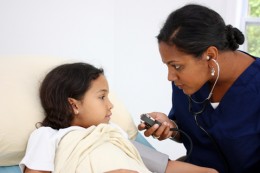High Blood Pressure in Children a Growing Concern
 When you hear the words, high blood pressure, you probably think it’s a problem that only affects adults. While this was the case just a generation earlier, sadly, this is no longer true. Today, high blood pressure in children is a growing concern. But what’s worse, they are also being hospitalized for it. According to a study published in the medical journal Hypertension, the number of children seen as hypertension inpatients in U.S. hospitals nearly doubled in ten years.
When you hear the words, high blood pressure, you probably think it’s a problem that only affects adults. While this was the case just a generation earlier, sadly, this is no longer true. Today, high blood pressure in children is a growing concern. But what’s worse, they are also being hospitalized for it. According to a study published in the medical journal Hypertension, the number of children seen as hypertension inpatients in U.S. hospitals nearly doubled in ten years.
Furthermore, those children treated for hypertension symptoms (high blood pressure symptoms), stayed in the hospital longer than children treated for other illnesses. The lead author of the study, Dr. Cheryl Tran, pediatric nephrology fellow in the Department of Pediatric Nephrology at the University of Michigan in Ann Arbor, reported that children treated for high blood pressure stayed in the hospital for an average of 8 days compared to 4 days for other conditions.[1]
What Causes High Blood Pressure in Children?
The high blood pressure causes in children can be varied. Sometimes, uncontrolled factors contribute to high blood pressure, especially in younger children. Uncontrolled factors would include health conditions such as kidney disease or heart defects. However, there are known controlled factors that also contribute to the rise in high blood pressure in children. That is, children can develop hypertension for the same reason adults do – eating a poor diet and not exercising. It’s no coincidence that the rise in childhood hypertension rates directly correlates with the rise in both childhood obesity and diabetes!
High Blood Pressure Symptoms in Children and Teens
If a child’s high blood pressure is not corrected, it can lead to deleterious and often very serious health consequences. Uncontrolled high blood pressure can cause the following short-term (acute) symptoms:
- Vomiting
- Blurred or double vision
- Headaches
- Shortness of breath
- Confusion and disorientation
- Chest pain
- Seizures
If your child has been diagnosed with high blood pressure and they begin to experience any of these symptoms listed above, you should seek medical attention right away.
High Blood Pressure Complications
The more worrisome consequences of hypertension in children are the long-term health effects than can ensue. A common complication associated with high blood pressure in children is sleep apnea, a sleeping disorder in which breathing repeatedly stops and starts during sleep. Sleep apnea is more prone to occur in children who are overweight and can cause irregular heartbeats, diabetes, depression, ADHD, and even heart failure.
Aside from sleep apnea, children with high blood pressure are more likely to have heart disease, kidney disease or a stroke. In fact, strokes in children are more common than would be suspected. About 10 out of every 100,000 children have a stroke every year and one of the most common causes of these strokes is heart disease. Often, a stroke is the first symptom of heart disease in children.[2]
Kids who have high blood pressure are likely to continue to have high blood pressure as adults unless they begin treatment. If a child’s high blood pressure persists into adulthood, aside from stroke, kidney disease and heart disease, they are also more likely to suffer a heart attack.
Hypertension Guidelines for Children and Teens
Now you know that high blood pressure left untreated puts your child’s health at serious risk. So, what do you do? Is it better to put your child on a medication right away or do you have time to try lifestyle changes first? To learn about your treatment options, click here to read our next article regarding hypertension guidelines for children and teens. Also read up on 7 Foods that Lower Blood Pressure here.
[1] Catharine Paddock PhD. (2012, June 20). “Kids In Hospital With High Blood Pressure Double In Ten Years, US.” Medical News Today.
[2] “Management of stroke in infants and children.” Circulation. 2008; vol 117.
This blog originally appear in 2012 and has been updated.


 Ask the EN Experts March 2025
Ask the EN Experts March 2025  Vegan Diet Better Than Omnivore Diet for Cardiovascular Health
Vegan Diet Better Than Omnivore Diet for Cardiovascular Health 